Friday 19 January 2007
Fin whale

The
Fin Whale (Balaenoptera physalus) is a Baleen whale and is the second largest whale and also the second largest animal currently living in the world. The
blue whale is the largest. The Fin whale can grow up to 26 meters in length. There are two groups of Fin Whales in the world, north and south. The two groups do not interbreed and never meet. Species from the Southern group can become larger (up to 26 meters) than the Northern group (21 - 23 meters). Can you guess the weight of a 26 meter long Fin whale? Its weight is around 120,000 kilograms! Apart from its gigantic size it is distinguishable by a white patch on its right jaw (not the left) as you can see from
this picture. In the early days of whaling, the Fin whale was too fast for the whalers to catch them. This changed with the coming of steam-powered boats. The Fin whale soon became the most hunted Cetacean of the world (at its peak there were 30,000 killed annually) and is listed as endangered now (now they are only hunted by humans on the coast of Greenland, killing about 10 Fin whales a year).
You can help spreading the word about this animal by liking it on facebook
Permanent Link
Wednesday 17 January 2007
Pygmy Marmoset
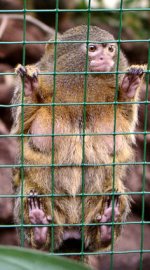
The
Pygmy Marmoset (Callithrix pygmaea) is the smallest monkey in the world (13 - 17 cm, head and body length) and lives in South America, in Peru, western Brazil, Ecuador and south-east Colombia. The have specially adapted claws for climbing trees. Pygmy marmosets are omnivorous, their diet consists of insects, spiders, small
reptiles, fruits, leaves and tree sap. About 2/3 of their time they are removing tree bark to reach the sap. They live in groups in the trees and are very active creatures, swiftly running and jumping in the trees. Due to habitat loss, the Pygmy marmoset may become threatened.
You can help spreading the word about this animal by liking it on facebook
Permanent Link
Tuesday 16 January 2007
Indian Muntjac deer
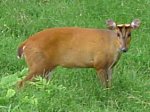
The
Indian Muntjac deer (
Muntiacus muntjak), also called the 'barking deer', is the most numerous of the Muntjac deer and lives in South-eastern Asia, in Pakistan, India, Nepal, and along South-eastern Asia and southern China. It gets its nickname 'barking deer' because of their barking like dogs when threatened. Their diet consists of leaves, grasses, shoots, and fallen fruit. Muntjacs are considered a very primitive kind of deer, as they appeared 15-35 million years ago with fossils found in France and Germany. Muntjacs are hunted for their meat and skin, and are considered a pest in some areas, where they destroy the trees by ripping of the bark. The Indian Muntjac is not considered endangered.
Image of the Muntjac deer, photographed by Pratheepps, licensed under Creative Commons Attribution ShareAlike 2.5
You can help spreading the word about this animal by liking it on facebook
Permanent Link
Sunday 14 January 2007
Culpeo
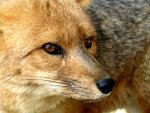
The
Culpeo (
Pseudalopex culpaeus) is a wild dog from South America, mostly the Western part. Culpeo societ is hierarchical and matriarchal, which means that the females try to stick with their territory and fight for it, while the males leave their natal territory. The dominant females eat first and also have exclusive breeding rights, which happens during the winter. The weight of the Culpeo ranges from 7 to 12 kilograms. Their main diet consists of hares, rabbits and rodents, but also insects, birds and berries. Culpeos are not endangered, but their main threat is habitat destruction as they are habitat specialists. Because they are habitat specialists, their population density is low and are quite rare, even though their range is quite large.
Picture of the Culpeo licensed under GDFL
You can help spreading the word about this animal by liking it on facebook
Permanent Link
Friday 12 January 2007
Commerson's dolphin

The
Commerson's dolphins (
Cephalorhynchus commersonii) are living in two distinct location: the 'southern tip of South America' and around the '
Kerguelen islands', the commerson's dolphins near Kerguelen Islands are a bit larger. They are also know by the names of 'Skunk Dolphin' and 'Piebald Dolphin'. The species was first described in 1767 by Philibert Commerson, and they look very much like porpoises, but is part of the dolphin family. Its diet consists of
fish, squid, and shrimp. From Marinebio.org: "These dolphins are at-risk of environmental contamination. Low levels of chlorinated hydrocarbons (DDT, PCB and HCB) were found in the blubber of Kerguélen dolphins, confirming the presence of contaminants in oceans far from the main sources of pollution. However, it was noted, that these levels were 10-100 times less than those of cetaceans in the North Atlantic".
You can help spreading the word about this animal by liking it on facebook
Permanent Link
Wednesday 10 January 2007
Spotted hyena
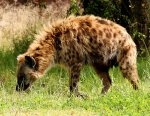
The
Spotted Hyena or 'Laughing Hyena' (
Crocuta crocuta) is the largest species of hyena. Its coat is sandy, yellowish or gray with dark brown spots on most of its body. Males are built lighter than females, males can weigh from 45 to 60 kg, while females can weigh 55 to 75 kg on average, but large females have been recorded that weigh up to 90 kilograms. The females are dominant over the males. Spotted hyenas form groups which are called 'clans', which can grow up to 80 members. The size of their territory varies extremely from as small as 40 square kilometers in the Ngorongoro crater to 1000 square kilometers in the Kalahari. The clans defend these territories, but can also make long foraging trips to the neares ungulate herd. This has been labelled a "commuting" system... Among other vocal communication, the Spotted hyena's trademark is the giggling. This is associated with fear or excitement and is often given when an individual is being chased. Its diet consists of a variety of animals, including
zebras, gazelles, wildebeest, topi, kongoni,
waterbuck, eland, impala,
warthog, hares, lions, ostrich eggs, Cape buffalo, bat-eared fox, golden jackal, porcupine, puff adder, domestic animals, termites, afterbirth other hyenas.
Image by rich115, found on Flickr, licensed under Attribution ShareAlike License v. 2.0
You can help spreading the word about this animal by liking it on facebook
Permanent Link
Tuesday 09 January 2007
Aardvark
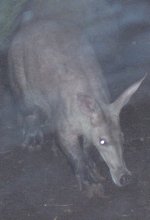
The
Aardvark (
Orycteropus afer) is a nocturnal, solitary animal, and is the only surviving member of the order Tubulidentata. It is placed alone in this order, because of its special teeth, which, instead of having a pulp cavity, have lots of thin tubes of dentine, each containing pulp and held together by cementum. Adults have only molars at the back of the jaw as teeth, the other teeth fall out. Its diet consists almost exclusively on ants and termites and the only fruit it eats: cucumber. The aardvark uses its front legs to dig out termites and ants and it uses them to create burrows. The aardvark weighs between 40 and 60 kilograms and is named after the Dutch words for "earth" and "pig". It lives in the sub-Saharan desert and is not threatened.
Did you know "Aardvark" is the first word in your English dictionary ? Picture of the Aardvark licensed under GFDL
You can help spreading the word about this animal by liking it on facebook
Permanent Link
Monday 08 January 2007
Vervet monkey
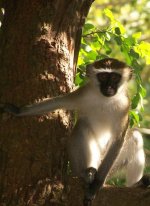
The
Vervet monkey (
Chlorocebus aethiops) are classified as vermin in Africa, where they occur in large numbers. They feed on the ground and sleep in the trees. Vervet monkeys live a life constantly running from being killed by humans. Males vary in size from 45 to 85 cm and weigh between 3.5 to 7.5 kg, while females, range from 40 to 60 cm in size and between 2.5 to 5.5 kg in weight. It lives in groups of up to 20 individuals. The Vervet monkey can become 20 years of age.
You can help spreading the word about this animal by liking it on facebook
Permanent Link
Wednesday 03 January 2007
Corsac fox
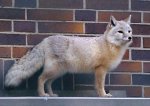
The
Corsac Fox (
Vulpes corsac) lives in the steppes and semi-desert of Central Asia. It does not dig its own burrows, but most of the time it takes over other animals' burrows. It is more social than other foxes and might even live together with other Corsac foxes in a burrow. Nocturnal in the wild, in captivity they are more active during the day. It is speculated that they have become more nocturnal in the wild, because of humans hunting the Corsac Fox, forcing it to become nocturnal. Their carnivorous diet mainly consists of rodents, pikas, birds and insects. They have a characteristic way to catch their favourite prey, rodents, by jumping in the air and dropping down on their prey.
Picture of the Corsac Fox by F. Spangenberg, licensed under GNU Free Documentation License.
You can help spreading the word about this animal by liking it on facebook
Permanent Link
 The Fin Whale (Balaenoptera physalus) is a Baleen whale and is the second largest whale and also the second largest animal currently living in the world. The blue whale is the largest. The Fin whale can grow up to 26 meters in length. There are two groups of Fin Whales in the world, north and south. The two groups do not interbreed and never meet. Species from the Southern group can become larger (up to 26 meters) than the Northern group (21 - 23 meters). Can you guess the weight of a 26 meter long Fin whale? Its weight is around 120,000 kilograms! Apart from its gigantic size it is distinguishable by a white patch on its right jaw (not the left) as you can see from this picture. In the early days of whaling, the Fin whale was too fast for the whalers to catch them. This changed with the coming of steam-powered boats. The Fin whale soon became the most hunted Cetacean of the world (at its peak there were 30,000 killed annually) and is listed as endangered now (now they are only hunted by humans on the coast of Greenland, killing about 10 Fin whales a year).
You can help spreading the word about this animal by liking it on facebook
The Fin Whale (Balaenoptera physalus) is a Baleen whale and is the second largest whale and also the second largest animal currently living in the world. The blue whale is the largest. The Fin whale can grow up to 26 meters in length. There are two groups of Fin Whales in the world, north and south. The two groups do not interbreed and never meet. Species from the Southern group can become larger (up to 26 meters) than the Northern group (21 - 23 meters). Can you guess the weight of a 26 meter long Fin whale? Its weight is around 120,000 kilograms! Apart from its gigantic size it is distinguishable by a white patch on its right jaw (not the left) as you can see from this picture. In the early days of whaling, the Fin whale was too fast for the whalers to catch them. This changed with the coming of steam-powered boats. The Fin whale soon became the most hunted Cetacean of the world (at its peak there were 30,000 killed annually) and is listed as endangered now (now they are only hunted by humans on the coast of Greenland, killing about 10 Fin whales a year).
You can help spreading the word about this animal by liking it on facebook 
 The
The  The
The  The
The  The
The  The
The  The
The  The
The  The
The